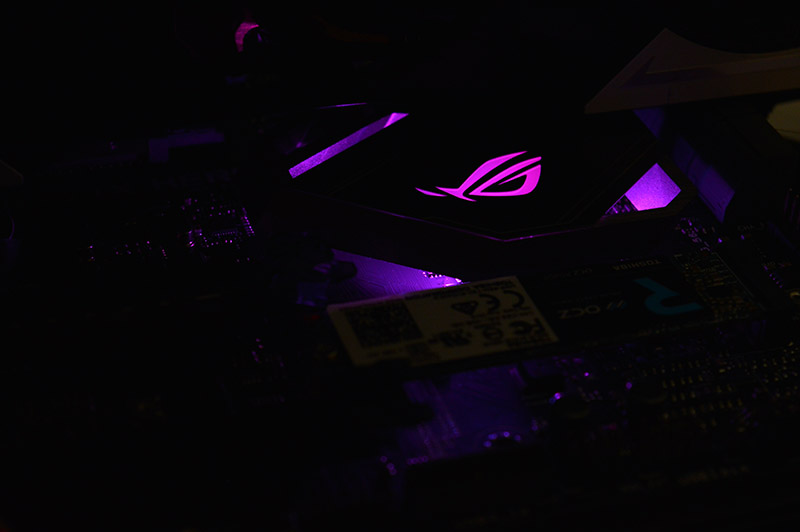ASUS Maximus IX Hero LGA1151 Motherboard Review
John Williamson / 8 years ago
A Closer Look
The ASUS Maximus IX Hero employs a neutral jet black and silver colour scheme which complements a huge range of components sporting contrasting designs. This understated, sophisticated theme dismisses the ROG aesthetic from a few generations ago which fixated on a red shade. Instead, the motherboard injects a hint of colour through RGB technology which means you can customise the appearance based on your own individual taste. For example, it’s possible to select your favourite hue, enable a vibrant transitional effect or turn off the illumination. Personally, I think the reliance on RGB to add colour is a wise move and prevents products from having a limited appeal.
Even though I describe the motherboard’s style as understated, the imposing heatsinks and I/O cover are beautifully designed which create a unique feel. More specifically, the brushed silver finish around the power delivery heatsinks is absolutely stunning and I love the small cut-outs which take the aesthetic beauty to another dimension. Furthermore, the PCH heatsink is really unusual and the pattern swooping across looks rather special. This detailing continues on the I/O cover which upholds a superb level of synergy.
In total, the motherboard has eight fan headers including five chassis headers, two pump headers and a high amp header. Interestingly, ASUS has engineered a new fan control IC capable of over temperature protection and over current protection. This protects the fan IC from becoming damaged due to a power surge and sudden thermal stress. Not only that, all of the onboard headers have PWM/DC detection which can be tuned using Fan Xpert 4. Also, the CPU fan headers and chassis fan headers support the Extreme Quiet Mode which creates a silent desktop experience during low CPU utilisation circumstances. The high amp fan header can cope with up to 3A for a PWM fan and 1A if you attach a DC fan. On a similar note, the water pump header is rated for up to 3A which makes it suitable for custom loop cooling hardware. If you own a closed-loop-cooler, the AIO_Pump header will be a great option at 1A. Both of these default to 100% duty so you don’t have to worry about the pump failing to reach its full speed. ASUS included two water cooling temperature Sense headers and a water flow Sense header to monitor system values. If you feel the motherboard’s fan configuration isn’t enough for some reason, it’s possible to connect a fan extension card.
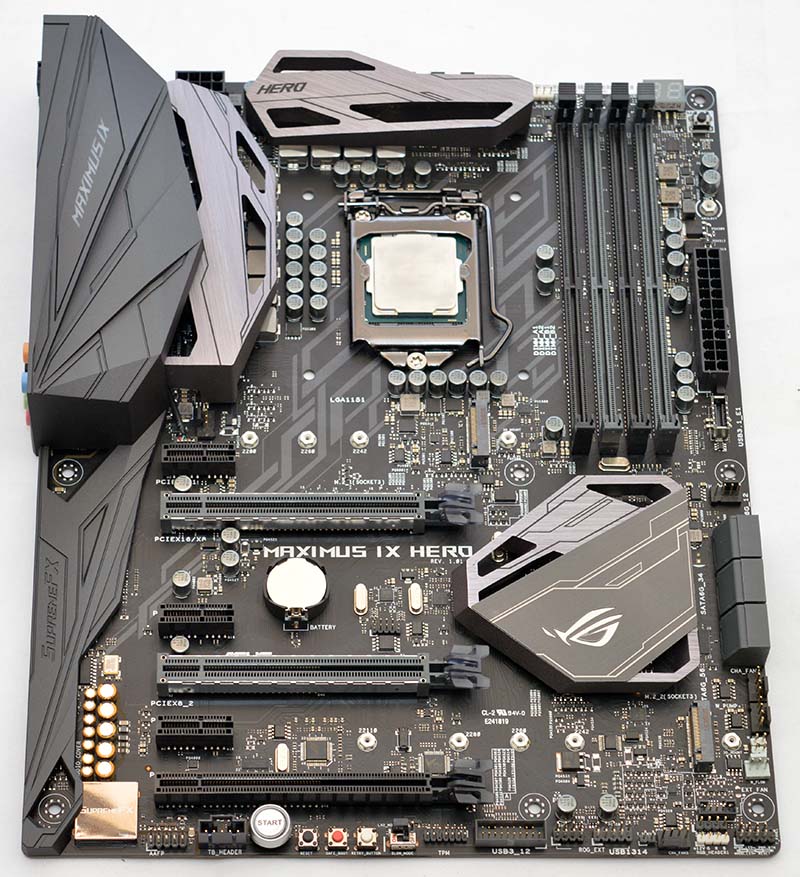
The motherboard utilises an Extreme Engine Digi+ 8-phase power delivery for the CPU and 2-phases are directed to the iGPU. Furthermore, the memory has its own dedicated 2-phase power design. As expected, the product opts for MicroFine Alloy chokes which are 31 percent cooler than large granules and offer a 75 percent less hysteresis reduction. This greatly improves the efficiency at higher currents which aids stability. The motherboard’s Texas Instruments NexFET MOSFETs are 50 percent smaller than traditional alternatives and have an excellent efficiency rating. Also, the Japanese-made 10K black capacitors have a 20 percent greater temperature endurance and exceedingly long lifespan.
ASUS’ BCLK generator works alongside the Turbo Processing Unit to open up the options for overclocking. The full BCLK range becomes accessible with an adjustable clock amplitude and clock slew rate. As a result, you can tune the BCLK in smaller increments and push your CPU to its maximum potential. Additionally, the BCLK generator has a less jitter and is a really handy feature for overclocking aficionados. The LANGuard uses signal-coupling and surface-mounted capacitors into a single chip to provide superb ESD protection. According to ASUS, this invention cuts the signal loss from 130KHz to 300MHz.
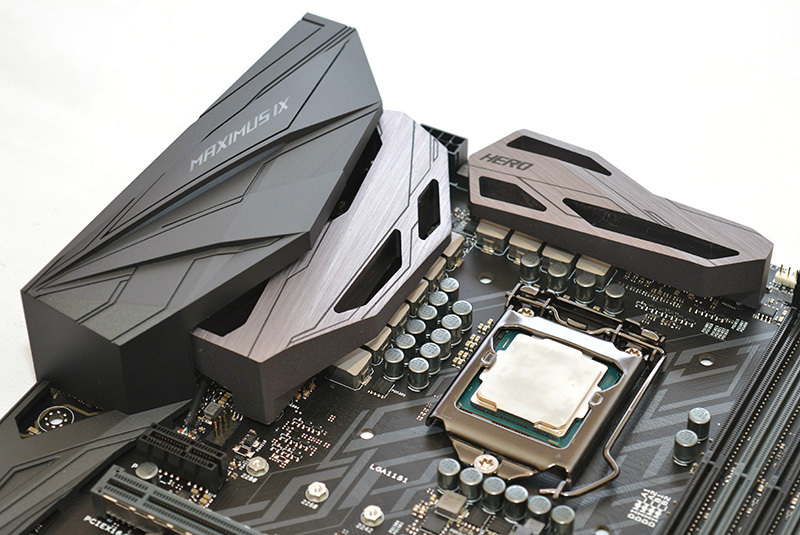
In terms of memory support, the motherboard can accept up to 64GB with a maximum rated speed of 4133MHz. Of course, this isn’t a viable target for most people and they’ll simply enable their memory kit’s XMP profile. ASUS’ 3rd generation T-topology circuit reduces crosstalk electrical interference which creates an enhanced signal integrity. ASUS worked with key upstream vendors to improve the T-topology process. Near the 24-pin ATX connector is a screw to attach your own 3D printed piece and add a personal taste to the motherboard. The LED post readout is useful for system diagnostics and to check the stability of a particular overclock. The MEMOK! button is deployed to assess the memory stability which could be the root cause of boot problems.

The motherboard’s SupremeFX solution is based on a new S1220 codec with an 113dB signal-to-noise ratio line-in and 120dB line-out. As a result, the codec provides a better frequency response and dynamic range while exhibiting minimal noise. Not only that, the codec has an ESS ESS9023P 24-bit DAC and RC4580 buffer, The headphone amplifier utilises a 2.1Vrms output and can drive high-impedance headphones up to 600 Ohms. The de-pop MOSFET reduces pop noises and acts an impedance sense pathway. The impedance sensing automatically determines the optimal rating for connected devices between Performance (0-50 Ohms), Powerful (51-109 Ohms) and Extreme (109 Ohms and above). As expected, there’s a healthy supply of premium Nichicon capacitors which deliver a warm, rich sound with superb clarity. The SupremeFX shielding has a physical isolation guard which isolates crosstalk and other noise interference. Also, the left and right channel track separation work to reduce the audio interference.
Here we can see the ASUS Maximus IX Hero has three PCI-E slots and supports up to 2-way SLI and 3-way CrossfireX configurations at x16/x8/, x8/x8 and/x4/x4. Interestingly, ASUS’ Safeslot design has been improved upon and contains more solder points which reinforce the slot and adds a greater durability. More specifically, the extra soldering improves the strength on the X-axis by 16 percent, 66 percent on the Y-axis and 34 percent on the Z-axis. The fortifying shielding combats EMI and prevents the slot from being damaged by an aggressive installation. Underneath the final PCI-E x16 slot is a useful selection of buttons including Start, Reset, Safe_Boot, Retry_Button and Slow_Mode.
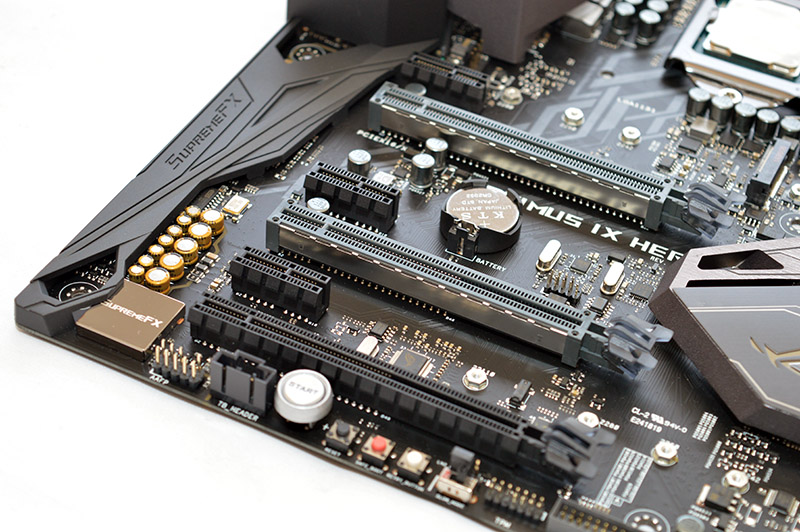
Connectivity-wise, the motherboard has six SATA3 ports, two M.2 ports and a USB 3.1 port positioned near the DIMM slots. The first M.2 connector supports type 2242/2260/2280 while the second can accommodate type 2242/2260/2280/22110 drives. The USB 3.1 connector allows you to reach speeds of 10Gb/s and ASUS has worked with Lian-LI and In-Win to ensure consumers can take advantage of this addition.
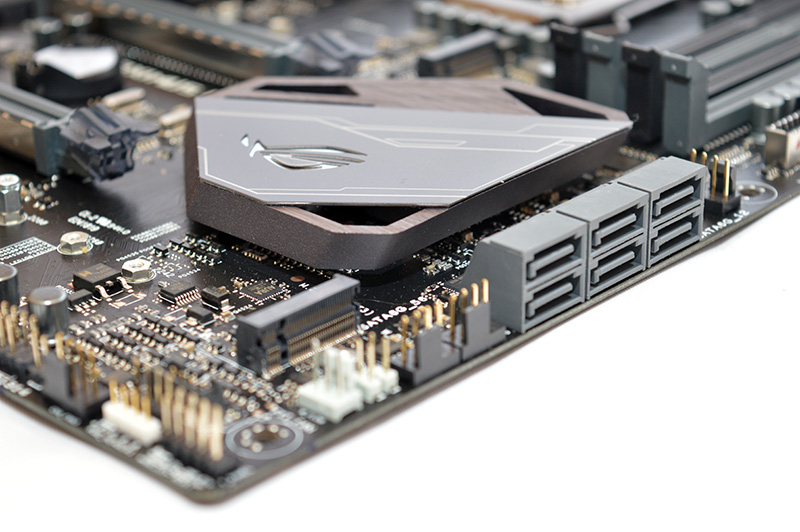
On the rear I/O, there’s a Clear_CMOS button, USB BIOS Flashback button, DisplayPort, HDMI, four USB 2.0 ports, four USB 3.0 ports, Intel i219V Gigabit LAN, USB 3.1 Type-A, USB 3.1 Type-C, five audio jacks and S/PDIF Out.
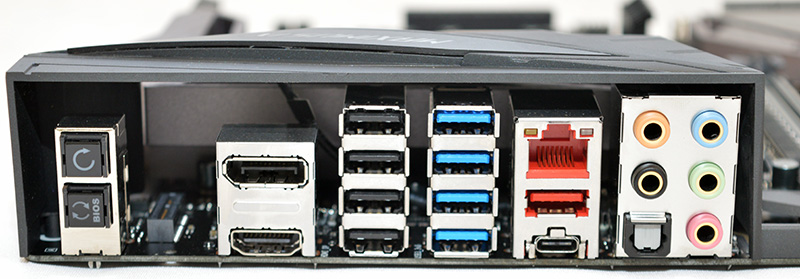
Unfortunately, it’s quite difficult to capture the Aura RGB lighting on camera in a way which reflects its true beauty. Rest assured the colours are extremely vibrant and a joy to look at. The motherboard’s Maximus logo lights up on the I/O cover and the PCH contains RGB technology. ASUS incorporated two headers which can control 5050LED strips and it’s possible to connect other RGB lighting peripherals and modify their visual style. The software houses a huge range of transitional effects including breathing, colour cycle, strobing, rainbow, comet, flash and dash. Furthermore, the lighting can be tuned to a music track or change depending on temperatures.

The RGB lighting in the PCH looks absolutely breathtaking and it’s great to see the iconic ROG logo being proudly displayed.
